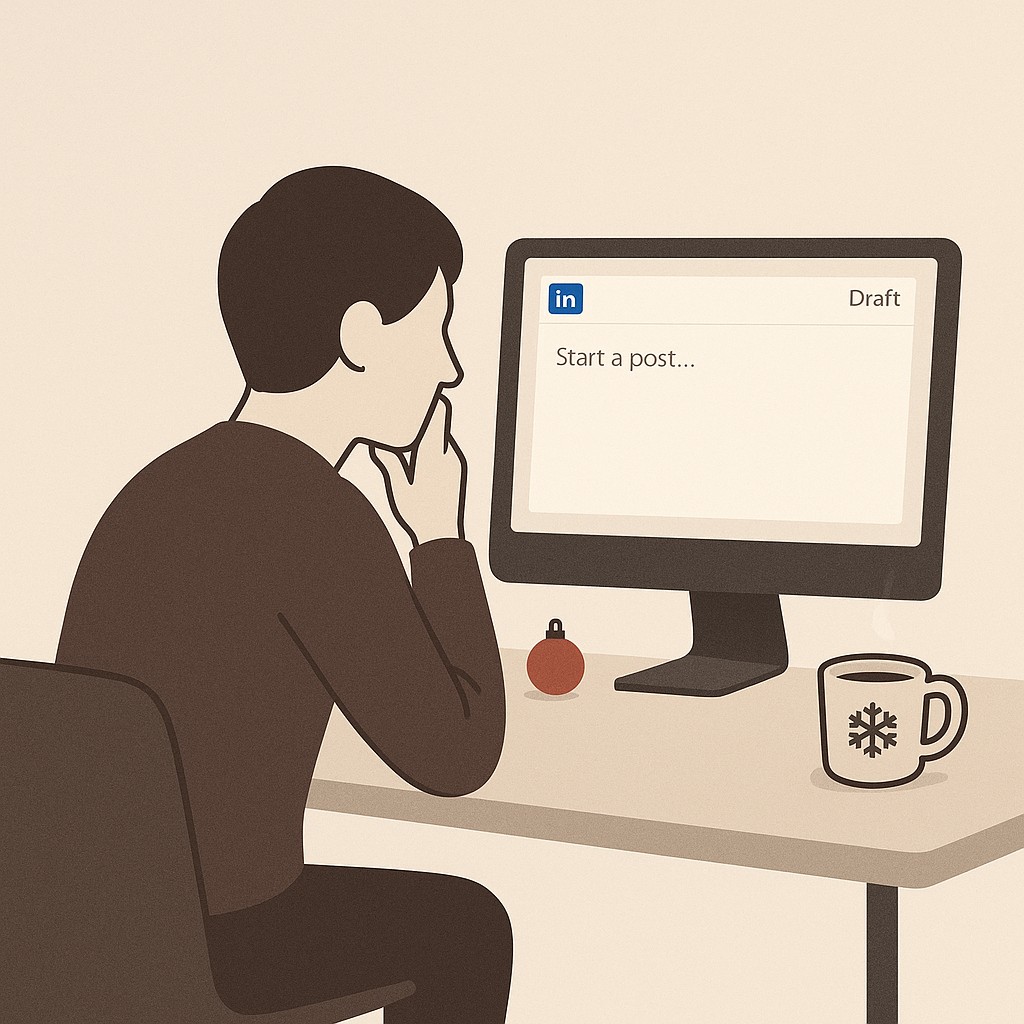How to Avoid Projection Bias: A One-Minute Check for Better Code and Collaboration
How to Avoid Projection Bias: A One-Minute Check for Better Code and Collaboration

Catching Your Own Bubble
It was Christmas Eve, and there I was staring at my LinkedIn draft, debating whether hitting publish would even matter. Everyone was signing off, right? Would anyone actually read it today?
Then it hit me—learning how to avoid projection bias started with seeing I was projecting my own situation onto the world. Of course I wanted a day off; of course I assumed everyone else did too.
But the truth is, not everyone has the same schedule. Different teams, roles, and time zones mean some folks are just logging in for the day while I’m winding down.

Some people might be online precisely because they’re seeking a spark—connection, information, or even a nudge of motivation when things feel quiet.
And of course, not everyone celebrates the same holidays I do. That moment of self-awareness? It keeps rippling forward. Widening our perspective doesn’t just change what we post—it transforms how we build, ship, and connect.
How to Avoid Projection Bias That Quietly Warps Our Engineering
Projection bias is when you quietly assume that everyone else thinks, works, and solves problems just like you do. If you’ve ever written code that ran perfectly on your laptop but then mysteriously broke in production, you’ve seen it in action. We trick ourselves into believing our environment is universal—the same OS, the same network speed, the same access rights—simply because those are the variables top of mind for us. But as anyone who’s deployed at scale knows, those invisible gaps between “my setup” and “the real world” are where most bugs and misunderstandings breed.
It doesn’t stop with machines or code, either. It shows up every time we write a feature that makes sense for our tools but not for our users, instead of designing to avoid assumptions about users, or setting a release time that works for our commute but not our colleagues’ time zones. Maybe you’re crafting an AI prompt using the clean, complete English sentences you’d use—but your end users are filling it with jargon, code-mixed language, or half-sentences on a laggy phone. Or you assume fast internet and overlook how a struggling connection trashes a seamless workflow. Even accessibility—an acronym or a color contrast issue—can slip by because your default isn’t everyone’s reality.
This is the trap. Our defaults are not defaults. They’re just starting points. When we break out of our bubble and ask, “Who’s missing here? What doesn’t fit if I loosen just one of my assumptions?” that’s when things start to click for more people, not fewer.
I’ve merged more than a few PRs that sailed right through my workflow—and then found out, only after QA or support flagged the disconnect, that real friction landed on an international teammate, a power user, or even a beginner. “Optimized for my constraints” is a nice way of saying I missed the bigger picture. That habit can cost time, trust, and energy down the line.
The fix doesn’t have to be heavy. Before you ship, spend 60 seconds scanning for the blind spots to prevent projection bias. That tiny pause can save hours of frustration for you and everyone else. #IntentionalLiving
The 60-Second Perspective Shift
Sixty seconds. That’s all it takes to avoid expensive, sweaty hours of rework and missed context later on. This isn’t about stalling before you ship. It’s about quick, deliberate precision. Here’s what changed for me: sixty seconds spent considering another point of view can quickly shift how we see ourselves and others—perspective takers routinely align with those they interact with. When I started practicing this, features landed better, code merged cleaner, and team trust deepened. Hashtag#PerspectiveShift.
Step one: pause. Literally just stop for a breath. Name your current assumptions out loud or in your head—“I’m optimizing for my own IDE, my bandwidth, my favorite dataset.” It’s almost embarrassing how much clarity I’ve gained by admitting what I was really optimizing for. Playbook: pause ask reframe act—four steps to reset your defaults.
Now, ask yourself—who does this impact? What constraints are baked into their day? What’s missing from my view? Take this to your code: whose environment gets hit? In PRs: who’s stuck on review rotation in a tricky time zone? Prompts and evals: who will be squinting at my test slice with a different set of expectations or tools? Sometimes just listing out who’s at the table (and who isn’t) changes everything.
Next up: reframe. So you’ve surfaced the assumptions—what’s the smart tweak? Could you add an edge-case test for flaky networks? Should you pick a default setting that fits less-technical users? Maybe the copy needs that extra line for folks who haven’t seen this workflow before. Are your AI prompts too tightly coupled to one style of input? Do your eval datasets skip scenarios that occur outside your time zone or niche?
For me, this often meant pushing for a broader sample, adding a quick accessibility check, or reframing error messages to actually name what went wrong instead of assuming “everyone gets it.” Each time I reframed, the odds of someone running into a wall dropped sharply. It’s never about the perfect, universal answer—just a wider slice of reality.
Last: act. Make the tiniest meaningful move right now—add a comment noting your assumption, adjust the default, flag a question for later. Capture what you surfaced in a ticket or code comment so your team steps right into your thought process. These little moves compound. Your Move.
About two years ago, in the middle of crunch season, I remember wandering out for lunch and noticing that same menu board at the corner deli. For weeks, it listed a sandwich as “Thursday Special” every day. Nobody bothered to update it. On one level, trivial—I still got my lunch. But it weirdly stuck with me. Sometimes the “defaults” we leave lying around aren’t hurting anyone, but other times people are quietly navigating around them and nobody says a thing. These aren’t just small details—they’re little reminders to pause, notice, and ask if we’re building for the reality we think, or the one that’s actually there.
Where the Perspective Check Shows Up (and Pays Off)
Shipping code is where my old assumptions liked to hide. Before pushing anything live, I do a quick scan for the usual suspects. Anything that silently assumes everyone is on my time zone, speaks my language, has perfect network, or sees the same colors I do. Sometimes it’s as simple as adding a test for a flaky connection or toggling on a feature flag until I’m confident it’s solid everywhere.
Most days, just writing down in the code what I’m assuming—“works if the network is strong,” “defaults to UTC,” or “only English error strings for now”—keeps bad surprises from accumulating. Here’s what changed. Regional shutdowns caused 225 major Internet disruptions in 2024, so handling flaky connectivity isn’t just paranoia—it’s responding to realities. That subtle shift—planning for the messy edges—means less firefighting later.
PR reviews run smoother with a tiny change. Ask out loud, “What’s the hidden assumption here?” Even if the code looks right, requesting a simple counterexample test can open up thinking. My favorite move is to name the person—maybe it’s the support teammate or the user segment—whose workflow benefits from the proposed change. Even simple checklists lighten the load in reviews, especially on complex changes—cognitive effort drops meaningfully when you add structure. It’s a small lift that makes a difference, especially when my own brain feels spent.
Prompt and eval work is sneaky—so much can go right in your “default” language, domain, or length, but quietly fail for others. I used to think my eval set was fine until I started broadening the slice—what does this look like in another language, with different data, at odd character counts? Now, I log clear failure modes and drop annotations right in the file about what’s known to break or where context is missing.
It’s become a habit to note constraints so it’s easy for someone else to replicate, critique, or extend later. “Literal: LinkedIn” shows up in my test prompt list now, just as a reminder that even something as familiar as LinkedIn can be someone’s edge case. The goal isn’t perfection—it’s creating a reality check others can see and build from.
Product decisions always benefit from a little pressure-testing. I try not to settle for defaults that only make sense from my seat. Cross functional calls (Customer Experience, Data, Legal) help stress test not just copy and settings, but also rollout plans. The callback here is simple. What feels obvious in one context might break in another. If you list the actual people or teams impacted, it’s much harder to keep your blind spots to yourself.
None of these are heavy lifts—you’ve probably done versions of them already. The difference is naming the friction before you create it. That’s the “one minute” upgrade—a deliberate pause to let other realities in. It’s user empathy in engineering, and it pays off faster than you’d think.
The Pause that Accelerates Progress
I know the anxiety. Every second you hesitate before shipping feels like you’re dragging the team down. But that minute you spend doing a perspective check for engineers? It’s nothing compared to the time (and headaches) of rolling back a rushed feature, retraining a model that missed the mark, or cleaning up after trust is broken. If a feature fails quietly because you projected your schedule, your toolset, or your assumptions onto everyone else, the real slowdown starts then. The payoff for one intentional pause builds over the entire lifecycle. hashtag#MindfulLeadership
You’ll actually notice the difference. Fewer support pings, clearer tickets, better on-call sleep, less rework—these micro-pauses keep the inevitable frictions from snowballing into delays or fire drills down the line. That’s how teams protect big launches and avoid preventable headaches. hashtag#YourMove
Make it stick by tying the pause to real triggers—before you merge, before you hit send on a prompt, right ahead of a standup. Grab a sticky note checklist. Most importantly, ask your teammates to call out any default assumption you haven’t noticed yet. I’ll admit—I still need reminders, and sometimes a gentle nudge from a colleague is what pops my own bubble. hashtag#SelfAwareness
So here’s the challenge—borrow the lesson that started back on Christmas Eve and use it in your shipping rhythm. Pause, widen your perspective, and you’ll find greater connection, empathy, and understanding.
Apply the 60-second perspective shift to your writing by generating AI-powered posts that adapt to audience goals, constraints, and tone, so you can publish faster with clear, context-aware content.
If you’re ready to look beyond your bubble, like or comment—I want to know what happens when you do.
I still catch myself missing things, by the way. The pause doesn’t make you perfect. It just keeps you honest.
Enjoyed this post? For more insights on engineering leadership, mindful productivity, and navigating the modern workday, follow me on LinkedIn to stay inspired and join the conversation.
You can also view and comment on the original post here .
